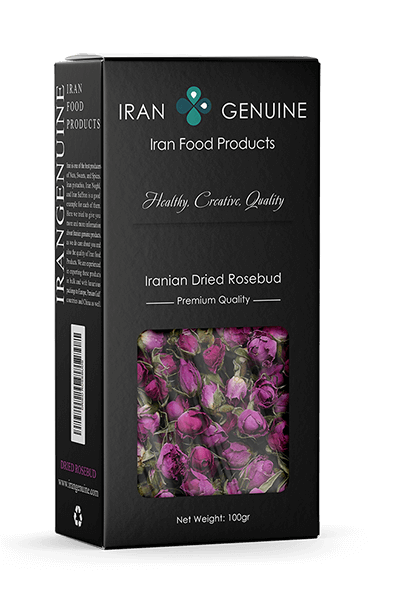
Fat (Per 100 gr)
0 g
Calories (Per 100 gr)
0 Kcal
Carbs (Per 100 gr)
65.37 g
Chol (Per 100 gr)
0 mg
Iran Damaask Rose History
Rosa Damascene or Damask Rose is more commonly known as “Gol-e Mohammadi” or Mohammadi Flower in Iran, which is a perennial herb from the Rosa type and the Rosaceae family, which has beautiful flowers in a variety of colors, most red and pink, and are derived from the rose. Most rosa damascene species are native to Asia, and some are native to Europe, North America, and Northwest Africa.
Mohammadi Rose Flower has been used in Iran since ancient times and the most important part of this flower is its petals. This flower’s effective substance is tannin. In Isfahan and Kashan, they take the rose water from it and some distill it.
Rosa Damascena Producers
Species of roses are also cultivated in Turkey and Morocco but are not qualitatively able to compete with Iran's Mohammadi Rose flower. Instead, the Bulgarian-made Mohammadi flower, mainly made in the Kazanlik Valley at altitudes of 300 to 500 meters above sea level, had the largest market share of this valuable product. In the south of France, a type of red rose exists, type of flower whose scientific name is Rosa centifolia, which is cultivated in the Grasse region of the perfume capital of the world, but its cultivation has gradually disappeared due to low production of rose essence.
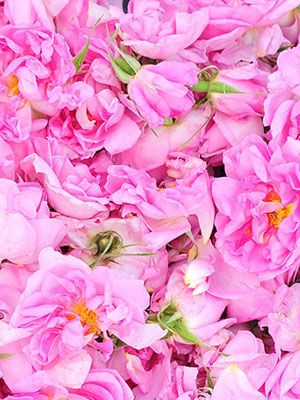
Iran Rosebud Export
Iran has a special place in the export of Rosewater in the world and every year a considerable amount of this popular product is exported to different countries all around the world. It should be noted that Kashan is the most important city in the field of rose and vegetable extracts, while other cities in the country have a significant role in the production of rose products. Rosewater has been exported to more than 30 countries in the world, including the United Arab Emirates, France, the United States, Canada, Germany, China, the United Kingdom, Austria, Australia, and Sweden.
Mineral Composition
Mohammadi Rose Flowers contain compounds such as carboxylic acids, Linalool (C10H18O), Eugenol, Citronellol (C10H20), Farnesol, Nerol (C10H18), Terpenes, Quercetin, Kaempferol, and Vitamin C. In the oil extract of this plant, 16-35% citronellol, 8-30% geraniol, 4-10% nerol, 4-16% nonadecane, 3-8% heneicosane and 1-3% linalool were found. Compounds such as Isoquercitrin, Afzelin, Quercetin gentiobiose, and Cyanidin-3-O-beta-glucoside have also been identified in Mohammadi flower’s buds.
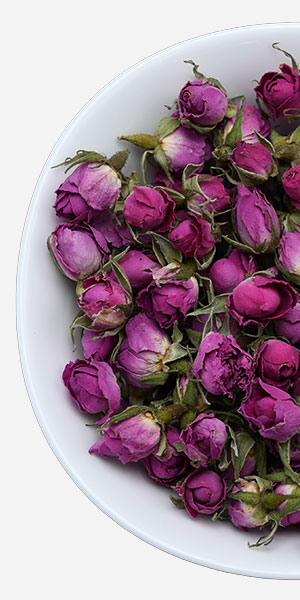
Damask Rose Uses
Iranian mostly use Damask rose in the food industry and perfumes. We know dried rosebud as a fragrant condiment for Iranian black tea. rose water also is used in halwa which is one of the Persian unique pastries. Rosebuds are combined in many authentic Iranian sweets and give them a pleasant aroma such as Gaz, Noghl, and ...
The main products
The main products are Golab (Rose Water), Rose Essential Oil, and Dried Petals, which are used in pharmaceuticals, perfumes, cosmetics, and food industries. Its medicinal uses are mainly in the treatment of rheumatic, cardiac, nervous, and gastric pains and in relieving some of the headaches, and in the preparation of jam syrup and the confectionery and ice cream industry.
Flower amber
Flower amber, as one of the by-products of the RoseWater industry, is a black liquid that remains in the pot at the end of the distillation operation and is suitable for muscle treatments. Brewed dried petals are a therapeutic effect to strengthen the nerves, relieve throat pain, and curing mouth diseases. In Iran Mohammadi flower’s wax, and sugar is also made as byproducts. Iranian RoseWater (Golab) and essential oils are exported annually to the Persian Gulf and European countries, including France and the United Kingdom.
Mohammadi Flower
Properties of Mohammadi flowers are very high, rose water consumption is more common in Iran and neighboring countries and more in Europe, America, and Canada. Mohammadi flower essence is used in the perfume industry, cosmetics industry, pharmaceutical industry, flower basket decoration, and In the preparation of cakes and sweets, and drinks.
Planting & Harvesting
The time that Mohammadi flowers start to open is from early May to early July, And in each region, the flowering time takes between 2-5 days. The flower lasts for a maximum of one day, after which the petals turn from pink to white, and with a slight breeze, the petals are inflated and shed.
The cultivated areas of Mohammadi Flower are mostly foothills and arid and semi-arid climates with temperate and arid summers and cold winters. Currently, Mohammadi Flower cultivation is carried out in 4 provinces of Iran, the most important of which are Kerman, Fars (Maymand), Isfahan (Kashan) and East Azarbaijan.
Damask Rose Distillation
With the arrival of spring and the months of May and June, Mohammadi's flowers surround the fragrance with a fragrant scent. At this time, various traditional and industrial pearl workshops, with distillers, distill the flowers early in the morning, before the bud is fully opened, arranged with water vapor in the boilers. The essential oils that have accumulated in the upper part of the fabric are removed and after diluting in a closed glass, they are kept away from light and the essential oil is produced in a container covered by dough. The remaining distilled water is used as "Rosewater" for various purposes. About 1 kg of essential oil is obtained every 3000 kg of the flower!
-
1
Planting
January, February, March
-
2
Harvesting
May, June
Requirements for Mohammadi flower cultivation
Although Mohammadi flower is grown in different climatic and natural conditions, it should be cultivated in a special geographical and natural environment, given the importance of its essential oil quality for more favorable results.
In general, the higher the altitude of the area and the colder the weather, resulting in a cold and semi-arid climate in winter and temperate and arid in summer, creating the best climate for this beautiful flower’s cultivation. 21 degrees Celsius is the temperature that this plant is best grown. The higher the essential oil you want in the flower, the higher the temperature difference between night and day should be, 5 to 10 degrees, especially at the end of the night.
Rosa Damascena benefits
Rosa Damascena medicinal uses
- Mohammadi flower products cure rheumatic pains.
- Useful for heart disease.
- Used to strengthen nerves.
- Relieves gastrointestinal discomfort, including stomach pain.
Rosa Damascena Properties
- It has a calming effect.
- It relieves Depression anger, fear and sadness.
- It treats poor blood circulation and heart disorders such as palpitations and hypertension.
- Dripping the extract of Mohammadi flower on the nose will cure headaches.
- Liver function Booster and gallbladder.
- Relieves respiratory distress, such as asthma, cough, and fever.
- It has moisturizing and hydrating properties, therefore it can cure damaged capillaries, skin inflammation, redness of the skin, eczema, and herpes.
- Mohammadi Rosewater is spirit boosting, exhilarating and antidepressant.
- Mohammadi flower petals are prescribed for the treatment of chronic diarrhea, female discharge, bloody sores, and normal bleeding.
- Rosewater syrup relieves the extra heat from the body.
Various products of Damask Rose
RoseWater (Golab)
Rosewater is a liquid that is extracted from Mohammadi roses (scientific name: Rosa damascena) and is fragrant.
Nowadays, Kashan city in Isfahan province in Iran is the largest producer of this product in the world with 15,000 tons of rose water production, followed by Kashmand city in Fars province with 12,000 tons of rose water production, which is the second-largest producer of this product in the world.
Rose water benefits
Rosewater is used to relieve complications from zokam (flu), stop bleeding from the chest, curing voice problems, cough, hot choking, stomach, and intestinal pain, cold and hot intestine, liver and spleen pain, cold stroke cure, hot headaches, sensory eye augmentation It is used as a disinfectant, a powerful cleanser for dry and sensitive skin. The smell of rose water has a direct effect on relaxation and relieves negative emotions and stress.
Rose water production process
To produce essential oil of rose and rosehip, it is necessary to start picking the flowers at about six o'clock in the morning and end as soon as the weather warms up before eight o'clock because as the weather warms, the plant (presumably to protect itself from heat) release some essential oils into the air. Therefore, the flowers arranged per day have a much lower essential oil yield. The picked flowers should be transferred immediately to the Rosewater production site or the essential oil production company, because the fermentation process of the flower will begin over time, increasing the temperature and destroying many of the subtle components of this masterpiece of nature.
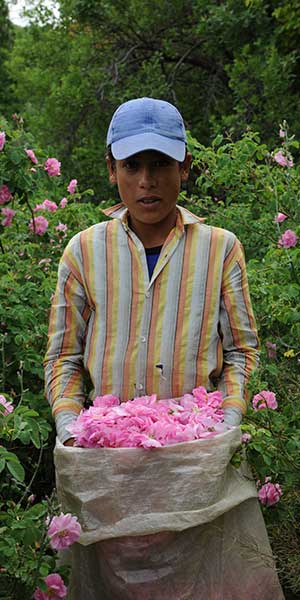
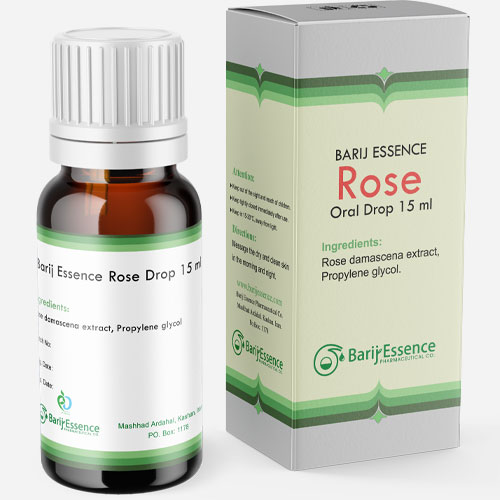
Rose Essential oil (Oral drop)
" Mohammadi flower essential oil is the most precious essential oil in the world! It is also expensive, as each kilogram of Mohammadi Flower essential oil costs about $ 8,000. "
The production of one liter of Mohammadi essential oil requires the use of 4 tons of flower petals, so it is a very valuable oil! One kilogram of rose petals is also used to produce each liter of rose water, but less pure rose water may have a lower price.
This product has lots of medicinal benefits and it's easy to use. Barij Essence company is one of the most famous producers of this product, you can inquire about rose essential oil price here.
Dried Rose buds
This product is a good option for use in tea and a variety of teas. Its unique taste and aroma are easily felt in your drink. You can also powder it and use it as a seasoning in food. Iranians use its powder and petals on yogurt, salads, and even desserts. It is also used in many countries to serve alcoholic beverages as a flavoring supplement.
Irangenuine offers this product with the best quality and most suitable packaging.

Precautions
- Damask rose, rosebud and rose hip tea are usually harmless, but eating rose hips and rose bush may cause side effects such as nausea and vomiting, diarrhea, constipation, heartburn, fatigue, insomnia, headache, stomach cramps and allergic reactions. Be in person.
- Excessive consumption of damask rose due to its high vitamin C may increase the risk of kidney stones.
- The abundant vitamin C in Rosa Damascena greatly increases iron absorption and is harmful to patients with thalassemia.
